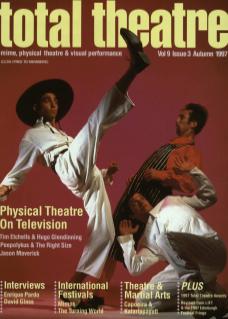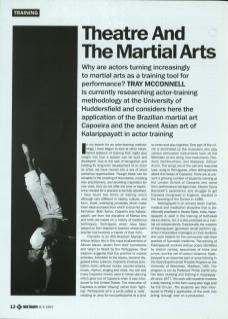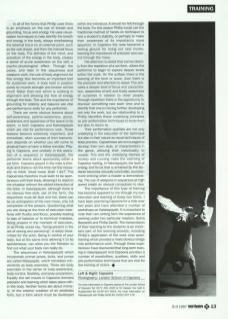In my search for an actor-training methodology, I have begun to look at other established systems of training that might give insight into how a system can be built and developed. Due to the lack of recognition and funding for long-term development of an actor as artist, we have moved into a era of short workshop opportunities. Though these can be valuable in the crossing of boundaries, meeting new practitioners, and providing inspiration for new work, they do not offer the time or experience needed for a practice to be fully absorbed. I have found two forms of training which although very different in history, culture, and form, share underlying principles which make them ideal as bases from which to train for performance. Both forms, Capoeira and Kalarippayatt, are from the discipline of Martial Arts and both are based on a history of traditional techniques. Techniques which have been passed on from teacher to teacher, where each teacher has become a master of their form.
Capoeira is an Afro-Brazilian Martial Art whose history lies in the mass enslavement of African slaves, stolen from their homelands and taken to Brazil by the Portuguese. Oral tradition suggests that the practice of martial activities, forbidden to the slaves, became disguised within a dance. Capoeira involves acrobatics, kicks, defence moves, counter-attacks, music, rhythm, singing and ritual. You can see many Capoeira moves used in break-dancing which grew out of Capoeira when it was introduced to the United States. The execution of Capoeira is called 'playing’ rather than ‘fighting'. Participants sit in a circle called a 'roda', creating an area for two participants at a time to enter and play together. One part of the circle is dominated by the musicians who play various percussion instruments such as the Berimbau (a one string, bow instrument), Pandeiro (tambourines), and Atabaque (African drum). The songs are of the call and response type, sung in Portuguese, often telling stories about the history of Capoeira. There are at present a growing number of students training at the London School of Capoeira who come from performance backgrounds. Mestre Sylvia Bazzarelli's persistence and struggle to get Capoeira recognised in England, resulted in the founding of the School in 1989.
Kalarippayatt is an ancient Asian martial, medical and meditation discipline that is traditionally practised in Kerala State, India. Kalarippayatt is used in the training of Kathakali dance-drama, but it is also practised as a martial art independently. Traditionally the masters of Kalarippayatt (gurukkal) would perform vigorous manipulative massages on their students and were healers for the community with their practice of Ayurvedic medicine. The training of Kalarippayatt involves animal poses identified by animal names, sequences of kicks and jumps, and the use of various weapons. Kalarippayatt is an essential part of actor-training in the Asian/Experimental Theatre Program at the University of Wisconsin, Madison, USA. The programme is run by Professor Phillip Zarrilli who has been studying and training in Kalarippayatt since 1977. His work with students involves a daily training in the form using also Yoga and Tai Chi Ch'uan. The students are then introduced to Phillip's application of the work into acting, through work on a production.
In all of the forms that Phillip uses there is an emphasis on the use of breath and grounding, focus and energy. He uses visualisation techniques to help identify the breath and energy in the body, always emphasising the external focus on an external point, such as the wall ahead, and then the internal focus on the body. The stillness of the mind, and activation of the energy in the body, creates a sense of acute awareness on the self, a psycho-physiological effect. Through the poses, and later in the sequences and weapons work, the use of body alignment for free energy flow becomes an important tool for sustained work. A body held in position purely by muscle strength and tension will tire much faster than one which is working in alignment and allowing the flow of energy through the body. This and the importance of grounding for stability and balance are vital pre-performance skills for any performer.
There are some obvious lessons about self-awareness, partner-awareness, group-awareness and awareness of the space to be learnt, in both Capoeira and Kalarippayatt which are vital for performance work. These lessons become extremely important, and immediate, when success of their transmission depends on whether you will come to physical harm or harm a fellow member. Playing in Capoeira, and similarly in the execution of a sequence in Kalarippayatt, the performer learns about spontaneity within a set form. Capoeira played in the roda is freestyle and there is not the time nor the necessity to think 'what move shall I do?' The Capoeirista therefore must learn to be spontaneous with their body, allowing it to react to the situation without the added interaction of the brain. In Kalarippayatt, although there is no obvious free-style use of the form, the sequences must be fluid and full, there can be no anticipation of the next move, only full completion of the present. Questioning what you are doing at the time of execution interferes with fluidity and focus, possibly leading to loss of balance or to technical mistakes. Being present in the moment of execution, or as Phillip would say, ‘being present in the act of seeing and perceiving’, is easily transmitted for the actor. Being in control of your body, but at the same time allowing it to be spontaneous, can allow you the freedom to find out what your body can really do.
The sequences in Kalarippayatt which incorporate animal poses, kicks, and jumps are called Meippayatt, which translates conveniently as body exercises. These are body exercises in the sense of body-awareness, body-control, flexibility, and body-preparation. Equally the set moves in Capoeira demand precision and learning which takes place within the body. Neither forms are about mimicry, or the exterior creation of an aesthetic form, but a form which must be developed within the individual. It should be felt through the body. For this reason Phillip would use the traditional method of hands-on technique to test a student's stability, or perhaps to make their awareness of its importance more apparent. In Capoeira the roda becomes a testing ground for trying out new moves, learning the importance of precision and control through the move.
The attention to detail that comes directly from the repetition of a set form, allows the performer to begin to explore deeper levels within the work. On the surface there is the learning of the form or score, then there is the precision and attention to detail. This activates a deeper level of focus and concentration, awareness of self, and finally awareness of ourselves in relation to other people. Through repetition there is the opportunity to discover something new each time and to identify that one is moving further developing not only the work, but our relationship to it. Phillip identifies these underlying principles as pre-performative techniques to build from but also to return to.
Their performative qualities are not only underlying in the execution of the technique but also in their nature as visual techniques of body practice. Capoeiristas are encouraged to develop their own style, or characteristics in the game, allowing their individuality to appear. This and the underlying themes of trickery and cunning make the watching of Capoeira riveting. In Kalarippayatt, the level of energy and focus that is achieved by the students becomes naturally watchable, and even more enticing when a master is demonstrating. The use of weapons in sequences at high speed create an obvious compulsion to view.
The importance of this type of training has become apparent to me through my own execution and learning of these two forms. I have been practising Capoeira for a little over two years and have attended a number of workshops on Kalarippayatt. It is important to note that I am writing from the experience of working under two particular masters: Sylvia Bazzarelli and Phillip Zarrilli. The transmission of their teaching to the students is an important part of the learning process, including Phillip's application of the work onto actor-training which provides a more obvious bridge into performance work. Through these experiences I have discovered that long-term training in Kalarippayatt and Capoeira provides a number of possibilities, qualities, skills and pre-performative techniques that are vital for the training of actors.


